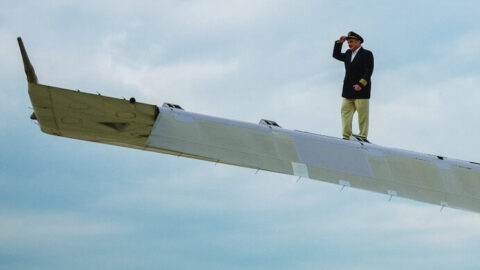Qasim Naqvi’s latest self-release album Film is a compilation of musical material composed for Naeem Mohaiemen’s film Tripoli Cancelled (2017) and audio video installation Two Meetings and a Funeral (2017). These works address issues personal to Mohaiemen, including the detainment of his father in an airport for nine days in 1977 and Bangladesh’s position within the non-aligned movement of 1973-74 respectively. Naqvi’s electronic soundscape, using analog modular synthesis systems, enlivens and comments on the characters, spaces, and histories presented in these two films.
Naqvi’s Film curates ten diverse sonic episodes from this material, exploring space age and cold war architectural sites, as well as cultural and socio-political references found in these two films. Naqvi states, “These sites steered me in the path of psychological room tones; a music that is an abstraction of natural ambiences that you hear in large deserted spaces.” The arc of the album guides the listener through an eclectic progression of these characteristically different resonant spaces. Naqvi’s detailed approach to the intricacies and indeterminacies of analog sound synthesis are exposed within the reiteration of similar highly rhythmic melodic motives and sonic gestures. These slight sonic variations are further amplified and personified by each resonant space, allowing for the expression of progressively more intimate musical ideas.
The opening track, The Cast, begins with a rich, brass like rhythmic and melodic ostinato which continues throughout. A sense of depth and variety is very quickly established, with aggressive oscillating sounds panning horizontally across the soundscape in opposition to mellow rising and falling pitches creating a vertical dimension. A sharp transient noise pattern echoing like footsteps on the hard cement floor of a massive enclosed arena opens Algiers. Out of this echo, an emerging, tightly pulsating sound gives way to waves of freely vibrating sonic textures. These forces build to a moment of quasi-harmonious consonance between the widely undulating waves of sound before quickly vanishing, revealing a final, deeper variant of the opening echoing sounds.

This dramatic silence sets the stage for the massive block of sound which begins Sputnik. The album’s prevailing rhythmic constancy takes on a new meaning here, as regular attacks of increasingly higher pitch and brighter timbre yield evolving, scintillating sustained sounds. Non-Aligned and Aligned present a radically different quality as a paired couplet exploring variations on a similar rising and falling melodic pattern. Non-Aligned is a lugubrious rendition of this pattern, loosely referring to the soundscape of The Cast, while Aligned features a rounder, agile sound to render a quicker, ironically jovial version.
If the narrative of Film to this point is expository, revealing new characters and ideas with each track, Coupole is something of turning point. Rhythmic and melodic repetition gives way to vast reiterations of continually developing sound gestures, drawing deeper attention and focus inward in increasingly large sonic spaces. In Coupole, vibration and dissonance caused by the grinding interaction of periodic rising and falling pitches release in breathtaking moments of resonant confluence. Plane Tower features an isolated sonic gesture which is expanded musically and spatially with each passing iteration. The bending pitches which begin each iteration have a moaning, almost human quality that give way to an eerie, billowing sonic texture. Mannequin presents the now familiar gestural technique morphed from an expansive sonic exegesis to an intimate conversation. Hollow, almost bell like effects tenderly, but temporarily embrace the listener, quickly decaying in to infinite space. All previous oscillations, repetitions, and iterations have been a set up to this fragile moment between blissful nostalgia and unbearable loneliness. This is no doubt the partial result of Sarah Register’s mastering, which facilitates Naqvi’s desire for dynamic conception of space and proximity throughout the album.
QASIM NAQVI // FILM // OFFICIAL ALBUM TEASER from qasim naqvi on Vimeo.
This creates the most powerful moment of the album, the emergence of Wreckage from the silence created in the void left by Mannequin. Beginning with a rumbling wall of noise seemingly comprised of all previous sounds heard thus far, viscerally powerful yet veiled harmonic melodies emerge. At the climax of Wreckage, the rumbling wall of noise gives way to a propulsive drum like motive which fades away to nothing, never reaching its full power. Chronoredux serves as a contemplative coda, quietly glancing back at the various motives and techniques experienced in the past 27 minutes.
While the concise nature of Naqvi’s selections on Film may leave the listener wanting a lengthier, more developed product, the poetic density of each work justifies itself. Ultimately, Naqvi’s iterative aesthetic in Film necessitates the broadest contextual lens possible, both viewing the works in aggregate as well as in context of the films they accompany. Exposing fleeting moments of memory, reflection, processing, and recognition amidst vast soundscapes, Naqvi excels in creating a nuanced mode of episodic discourse which complements Mohaiemen’s approach in the two films. His creation of distinct spaces within each track invites the listener to insert themselves in to this discourse in a novel way.
























